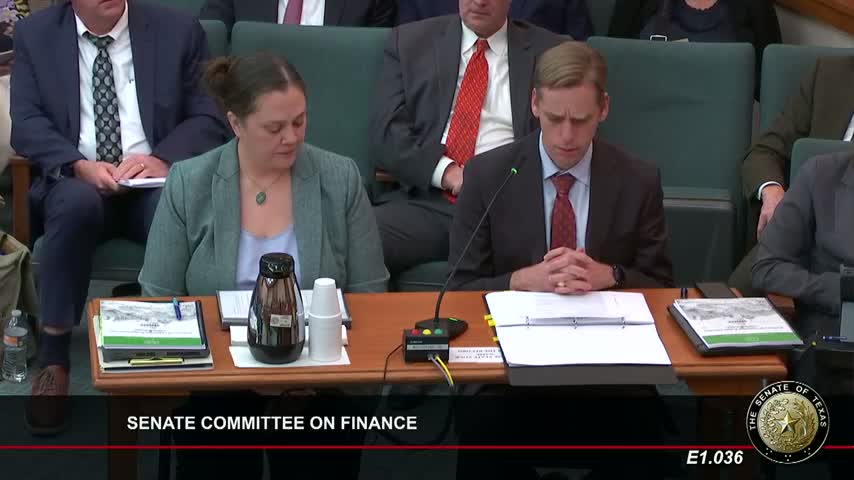Legislative analysts: property‑tax relief costs rose from $18B to roughly $22.7B due to hold‑harmless rules and valuation assumptions
January 27, 2025 | Senate, Legislative, Texas
This article was created by AI summarizing key points discussed. AI makes mistakes, so for full details and context, please refer to the video of the full meeting. Please report any errors so we can fix them. Report an error »

The Legislative Budget Board told the Senate Finance Committee that estimates of the cost of the property‑tax relief measures enacted two years ago grew markedly after implementation because of the interaction of appraisal values, how the Foundation School Program computes tier 1 tax rates, and several hold‑harmless provisions.
Aaron Hendrickson of the LBB summarized the office’s post‑implementation review: “In developing the fiscal note for Senate Bill 2, our office assumed a district's tier 1 tax rate would be based off of a value that incorporated the $100,000 homestead exemption. In implementing the provisions of the bill, TEA used the value that incorporated the older $40,000 homestead exemption which provided for a higher property value and a lower tier 1 tax rate and provided additional compression.” The LBB analysis found the combined effect of that calculation choice and multiple holds harmless increased the projected cost of the package.
Hendrickson told senators that the LBB’s estimate of the biennial ongoing cost of the measures enacted in the prior session rose from the original $18,000,000,000 fiscal note to a much larger figure during implementation and coding of the Foundation School Program; the analysis identified two primary drivers: (1) which homestead‑exemption amount was used in the computations of district property values and resulting tax rate compression, and (2) interactions among several hold‑harmless formula provisions that amplified costs when property values rose faster than assumed.
The LBB also presented the committee with the SB1 assumptions for the next biennium: the budget text included a line‑item of $51,000,000,000 in total property‑tax‑relief‑related items for 2026–27, which the LBB broke into components such as ongoing costs from prior reforms, 3,000,000,000 to raise the homestead exemption contingent on legislation, and a $500,000,000 business relief placeholder. LBB staff said they estimate roughly a $400,000,000 general‑revenue shortfall in the Foundation School Program this current biennium related to enrollment and other student‑cost drivers.
Why it matters: The post‑implementation cost growth changed the baseline that lawmakers must fund in 2026–27. The LBB’s review underscores how technical implementation choices in school finance interact with property valuations and statutory hold‑harmless rules and how those interactions can produce substantially higher ongoing costs than the original fiscal note suggested.
Aaron Hendrickson of the LBB summarized the office’s post‑implementation review: “In developing the fiscal note for Senate Bill 2, our office assumed a district's tier 1 tax rate would be based off of a value that incorporated the $100,000 homestead exemption. In implementing the provisions of the bill, TEA used the value that incorporated the older $40,000 homestead exemption which provided for a higher property value and a lower tier 1 tax rate and provided additional compression.” The LBB analysis found the combined effect of that calculation choice and multiple holds harmless increased the projected cost of the package.
Hendrickson told senators that the LBB’s estimate of the biennial ongoing cost of the measures enacted in the prior session rose from the original $18,000,000,000 fiscal note to a much larger figure during implementation and coding of the Foundation School Program; the analysis identified two primary drivers: (1) which homestead‑exemption amount was used in the computations of district property values and resulting tax rate compression, and (2) interactions among several hold‑harmless formula provisions that amplified costs when property values rose faster than assumed.
The LBB also presented the committee with the SB1 assumptions for the next biennium: the budget text included a line‑item of $51,000,000,000 in total property‑tax‑relief‑related items for 2026–27, which the LBB broke into components such as ongoing costs from prior reforms, 3,000,000,000 to raise the homestead exemption contingent on legislation, and a $500,000,000 business relief placeholder. LBB staff said they estimate roughly a $400,000,000 general‑revenue shortfall in the Foundation School Program this current biennium related to enrollment and other student‑cost drivers.
Why it matters: The post‑implementation cost growth changed the baseline that lawmakers must fund in 2026–27. The LBB’s review underscores how technical implementation choices in school finance interact with property valuations and statutory hold‑harmless rules and how those interactions can produce substantially higher ongoing costs than the original fiscal note suggested.
View full meeting
This article is based on a recent meeting—watch the full video and explore the complete transcript for deeper insights into the discussion.
View full meeting
